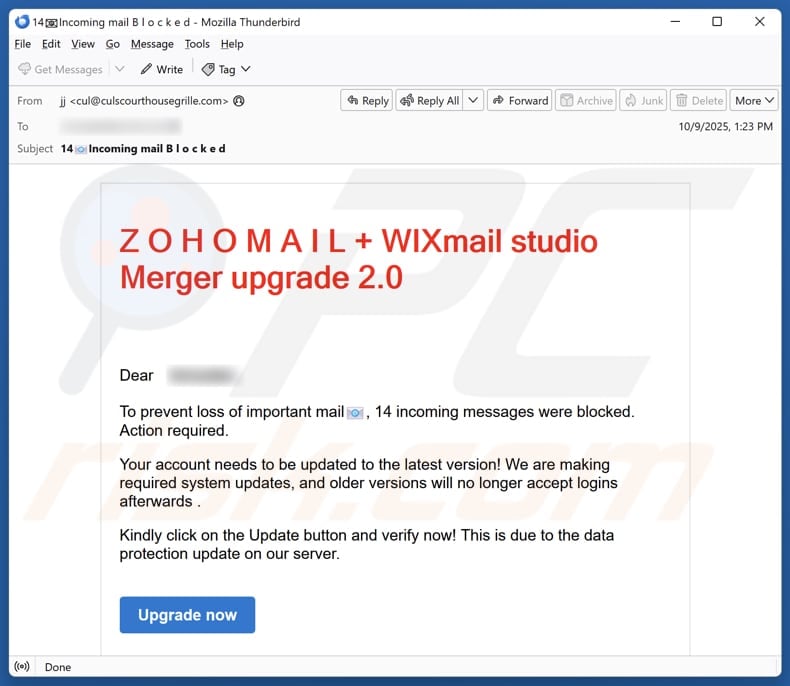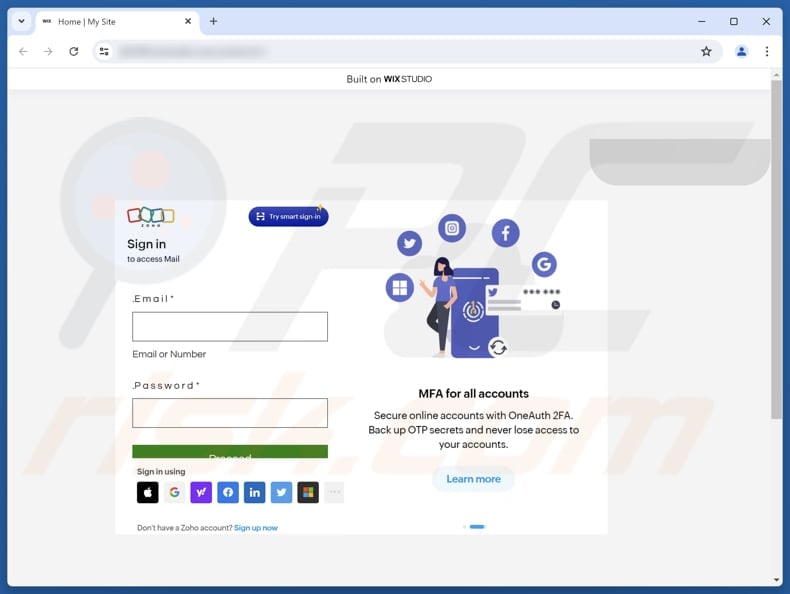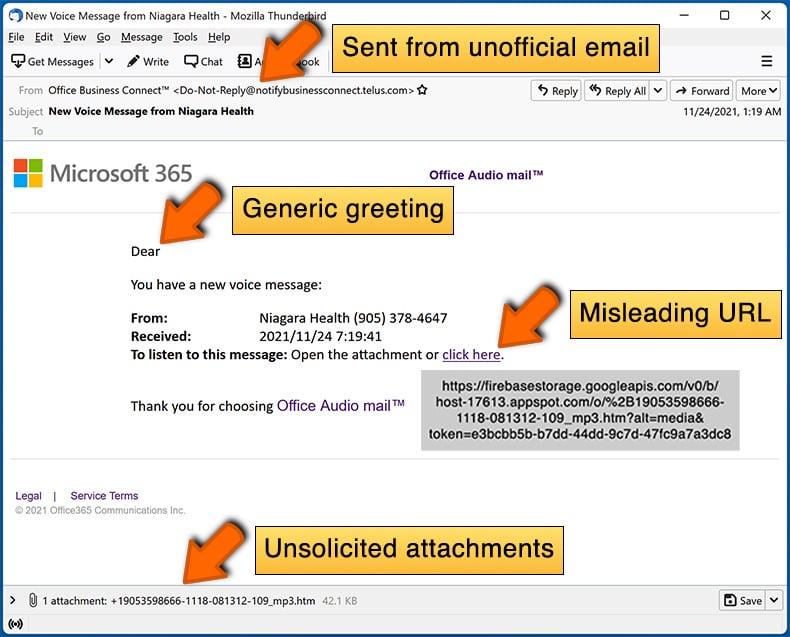How to identify scam emails ike "Zoho Mail + Wix Mail Studio Merger Upgrade"
Phishing/ScamAlso Known As: Fake Zoho Mail + Wix Mail Studio Merger Upgrade notification
Get free scan and check if your device is infected.
Remove it nowTo use full-featured product, you have to purchase a license for Combo Cleaner. Seven days free trial available. Combo Cleaner is owned and operated by RCS LT, the parent company of PCRisk.com.
What kind of scam is "Zoho Mail + Wix Mail Studio Merger Upgrade"?
Our team has examined the email and concluded that it is a phishing email posing as a notification from Zoho Mail regarding a merger upgrade. It is crafted to appear legitimate and trick recipients into entering personal information on a deceptive website. Recipients should not trust this email and should ignore it.

More about the "Zoho Mail + Wix Mail Studio Merger Upgrade" scam email
The email claims to be from a merged Zoho Mail and WIXmail studio service and announces an upgrade to version 2.0. It warns the recipient that 14 incoming messages were blocked and that their account must be updated to continue receiving emails. The message urges the recipient to click the "Upgrade now" button to verify their account.
It also threatens permanent disconnection if the update is not completed. Clicking the provided button (link) directs recipients to a fake sign-in website designed to steal email account login credentials (email addresses and passwords).
When scammers take over email accounts, they use them to send scam or phishing messages to the account contacts, reset passwords for other accounts, and access sensitive information stored in emails. They may also attempt to use the stolen login details on other sites, including social media, banking platforms, or other online services.
Additionally, stolen credentials and other personal data can be sold to other criminals. Therefore, it is essential to scrutinize suspicious emails before clicking links, opening attachments, or sharing any personal information.
| Name | Zoho Mail + Wix Mail Studio Merger Upgrade Scam |
| Threat Type | Phishing, Scam, Social Engineering, Fraud |
| Fake Claim | 14 incoming messages were blocked |
| Disguise | Notification from Zoho Mail and WIXmail studio service |
| Symptoms | Unauthorized online purchases, changed online account passwords, identity theft, illegal access of the computer. |
| Distribution methods | Deceptive emails, rogue online pop-up ads, search engine poisoning techniques, misspelled domains. |
| Damage | Loss of sensitive private information, monetary loss, identity theft. |
| Malware Removal (Windows) |
To eliminate possible malware infections, scan your computer with legitimate antivirus software. Our security researchers recommend using Combo Cleaner. Download Combo CleanerTo use full-featured product, you have to purchase a license for Combo Cleaner. 7 days free trial available. Combo Cleaner is owned and operated by RCS LT, the parent company of PCRisk.com. |
Conclusion
This scam demonstrates how scammers use fake emails to steal email login credentials and other information. Falling for it can compromise personal information, affect other accounts, and expose data to further illegal activity. Users should always verify emails carefully and avoid clicking links or sharing information when receiving suspicious emails.
Some examples of similar scam emails are "Adobe Acrobat Sign Request", "Review Your Recent Activity", "Salary & Performance Award", and "DocuSign - Project Proposal & Quantity Confirmation". It is important to note that deceptive emails can be used to distribute malware.
How do spam campaigns infect computers?
Malware is often delivered via email through infected attachments, such as executable files, Word or Excel files, PDFs, scripts, or compressed archives like ZIP and RAR files. Opening these attachments or enabling certain features, like macros, can execute the malware on the device.
Emails may also include links to fraudulent or compromised websites, which can automatically download malware or deceive users into running it themselves.
How to avoid installation of malware?
Avoid opening files or links in unexpected, irrelevant, or similar emails and messages. Be careful when visiting dubious websites, and do not click on pop-ups, ads, or other content encountered on them. Always download software from trusted sources, such as official websites or reputable app stores.
Do not allow notifications from questionable sites. Keep your operating system, applications, and antivirus software up to date, and run regular security scans.
Text presented in the "Zoho Mail + Wix Mail Studio Merger Upgrade" email letter:
Z O H O M A I L + WIXmail studio Merger upgrade 2.0
Dear - ,
To prevent loss of important mail, 14 incoming messages were blocked. Action required.
Your account needs to be updated to the latest version! We are making required system updates, and older versions will no longer accept logins afterwards .
Kindly click on the Update button and verify now! This is due to the data protection update on our server.
Upgrade nowContinue to access all the features you love - email, news, videos and more - without interruption by updating immediately. *
Please note: Failure to do this your account will be disconnected permanently.
Please do not reply to this email. This address is automated, unattended and cannot help with questions or requests..
Phishing site used in this scam:

Instant automatic malware removal:
Manual threat removal might be a lengthy and complicated process that requires advanced IT skills. Combo Cleaner is a professional automatic malware removal tool that is recommended to get rid of malware. Download it by clicking the button below:
DOWNLOAD Combo CleanerBy downloading any software listed on this website you agree to our Privacy Policy and Terms of Use. To use full-featured product, you have to purchase a license for Combo Cleaner. 7 days free trial available. Combo Cleaner is owned and operated by RCS LT, the parent company of PCRisk.com.
Quick menu:
- What is Fake Zoho Mail + Wix Mail Studio Merger Upgrade notification?
- Types of malicious emails.
- How to spot a malicious email?
- What to do if you fell for an email scam?
Types of malicious emails:
![]() Phishing Emails
Phishing Emails
Most commonly, cybercriminals use deceptive emails to trick Internet users into giving away their sensitive private information, for example, login information for various online services, email accounts, or online banking information.
Such attacks are called phishing. In a phishing attack, cybercriminals usually send an email message with some popular service logo (for example, Microsoft, DHL, Amazon, Netflix), create urgency (wrong shipping address, expired password, etc.), and place a link which they hope their potential victims will click on.
After clicking the link presented in such email message, victims are redirected to a fake website that looks identical or extremely similar to the original one. Victims are then asked to enter their password, credit card details, or some other information that gets stolen by cybercriminals.
![]() Emails with Malicious Attachments
Emails with Malicious Attachments
Another popular attack vector is email spam with malicious attachments that infect users' computers with malware. Malicious attachments usually carry trojans that are capable of stealing passwords, banking information, and other sensitive information.
In such attacks, cybercriminals' main goal is to trick their potential victims into opening an infected email attachment. To achieve this goal, email messages usually talk about recently received invoices, faxes, or voice messages.
If a potential victim falls for the lure and opens the attachment, their computers get infected, and cybercriminals can collect a lot of sensitive information.
While it's a more complicated method to steal personal information (spam filters and antivirus programs usually detect such attempts), if successful, cybercriminals can get a much wider array of data and can collect information for a long period of time.
![]() Sextortion Emails
Sextortion Emails
This is a type of phishing. In this case, users receive an email claiming that a cybercriminal could access the webcam of the potential victim and has a video recording of one's masturbation.
To get rid of the video, victims are asked to pay a ransom (usually using Bitcoin or another cryptocurrency). Nevertheless, all of these claims are false - users who receive such emails should ignore and delete them.
How to spot a malicious email?
While cyber criminals try to make their lure emails look trustworthy, here are some things that you should look for when trying to spot a phishing email:
- Check the sender's ("from") email address: Hover your mouse over the "from" address and check if it's legitimate. For example, if you received an email from Microsoft, be sure to check if the email address is @microsoft.com and not something suspicious like @m1crosoft.com, @microsfot.com, @account-security-noreply.com, etc.
- Check for generic greetings: If the greeting in the email is "Dear user", "Dear @youremail.com", "Dear valued customer", this should raise suspiciousness. Most commonly, companies call you by your name. Lack of this information could signal a phishing attempt.
- Check the links in the email: Hover your mouse over the link presented in the email, if the link that appears seems suspicious, don't click it. For example, if you received an email from Microsoft and the link in the email shows that it will go to firebasestorage.googleapis.com/v0... you shouldn't trust it. It's best not to click any links in the emails but to visit the company website that sent you the email in the first place.
- Don't blindly trust email attachments: Most commonly, legitimate companies will ask you to log in to their website and to view any documents there; if you received an email with an attachment, it's a good idea to scan it with an antivirus application. Infected email attachments are a common attack vector used by cybercriminals.
To minimise the risk of opening phishing and malicious emails we recommend using Combo Cleaner Antivirus for Windows.
Example of a spam email:

What to do if you fell for an email scam?
- If you clicked on a link in a phishing email and entered your password - be sure to change your password as soon as possible. Usually, cybercriminals collect stolen credentials and then sell them to other groups that use them for malicious purposes. If you change your password in a timely manner, there's a chance that criminals won't have enough time to do any damage.
- If you entered your credit card information - contact your bank as soon as possible and explain the situation. There's a good chance that you will need to cancel your compromised credit card and get a new one.
- If you see any signs of identity theft - you should immediately contact the Federal Trade Commission. This institution will collect information about your situation and create a personal recovery plan.
- If you opened a malicious attachment - your computer is probably infected, you should scan it with a reputable antivirus application. For this purpose, we recommend using Combo Cleaner Antivirus for Windows.
- Help other Internet users - report phishing emails to Anti-Phishing Working Group, FBI’s Internet Crime Complaint Center, National Fraud Information Center and U.S. Department of Justice.
Frequently Asked Questions (FAQ)
Why did I receive this email?
Scammers often distribute emails to many people at once, using lists of stolen addresses obtained from breaches, fake pages, or similar methods.
I have provided my personal information when tricked by this email, what should I do?
Immediately change any password that may have been exposed. If financial or personal identification information is affected, notify your bank and local authorities.
I have downloaded and opened a malicious file attached to an email, is my computer infected?
An executable (.exe) can immediately infect a computer, while malicious files like documents usually need additional user action, such as turning on macros, before the malware executes.
I have read the email but did not open the attachment, is my computer infected?
Opening an email does not put your device at risk. Malware can infiltrate only when you open harmful attachments or click on suspicious links.
Will Combo Cleaner remove malware infections that were present in email attachment?
Although Combo Cleaner can detect and remove most malware, running a full system scan is recommended because some sophisticated threats might remain hidden.
Share:

Tomas Meskauskas
Expert security researcher, professional malware analyst
I am passionate about computer security and technology. I have an experience of over 10 years working in various companies related to computer technical issue solving and Internet security. I have been working as an author and editor for pcrisk.com since 2010. Follow me on Twitter and LinkedIn to stay informed about the latest online security threats.
PCrisk security portal is brought by a company RCS LT.
Joined forces of security researchers help educate computer users about the latest online security threats. More information about the company RCS LT.
Our malware removal guides are free. However, if you want to support us you can send us a donation.
DonatePCrisk security portal is brought by a company RCS LT.
Joined forces of security researchers help educate computer users about the latest online security threats. More information about the company RCS LT.
Our malware removal guides are free. However, if you want to support us you can send us a donation.
Donate
▼ Show Discussion